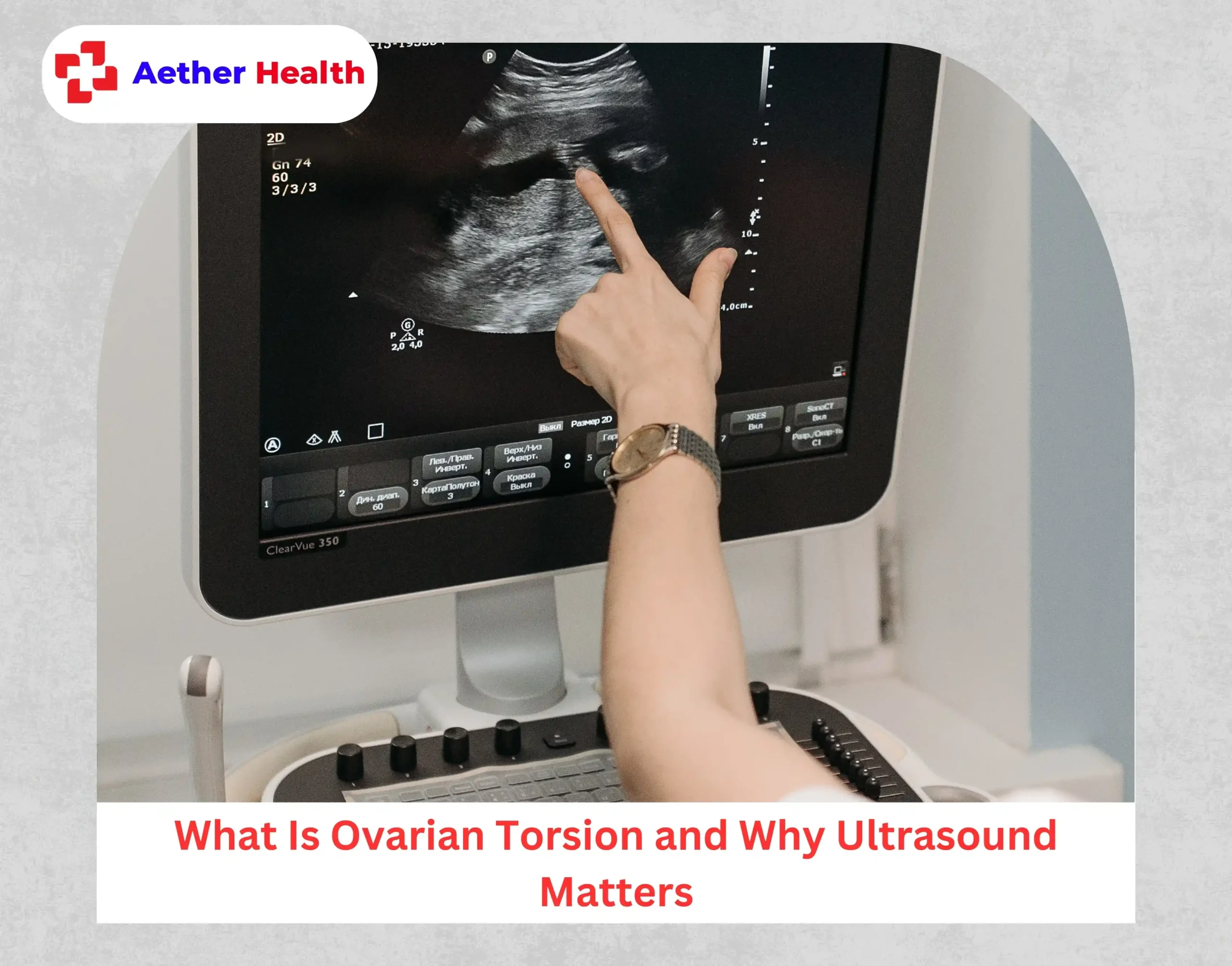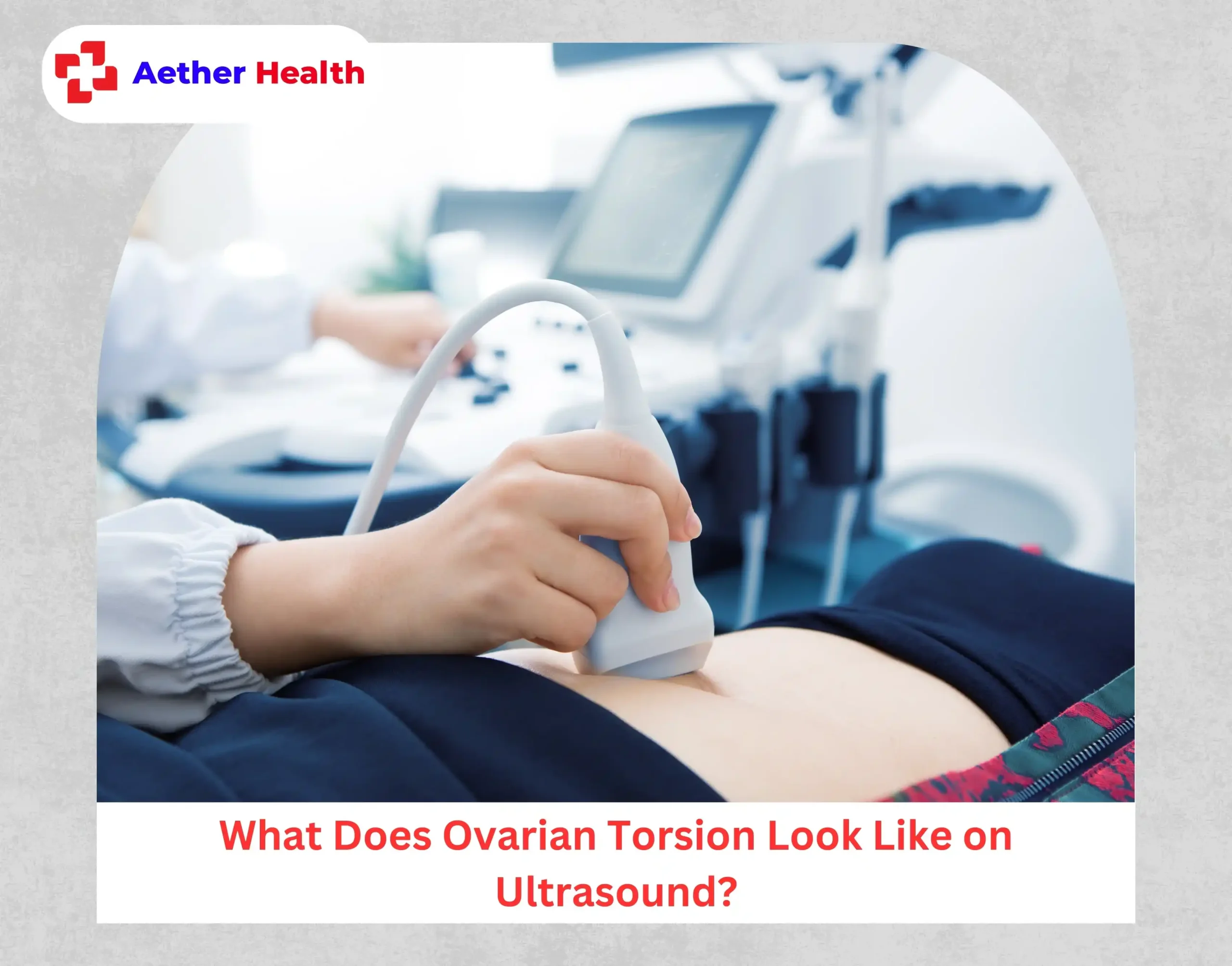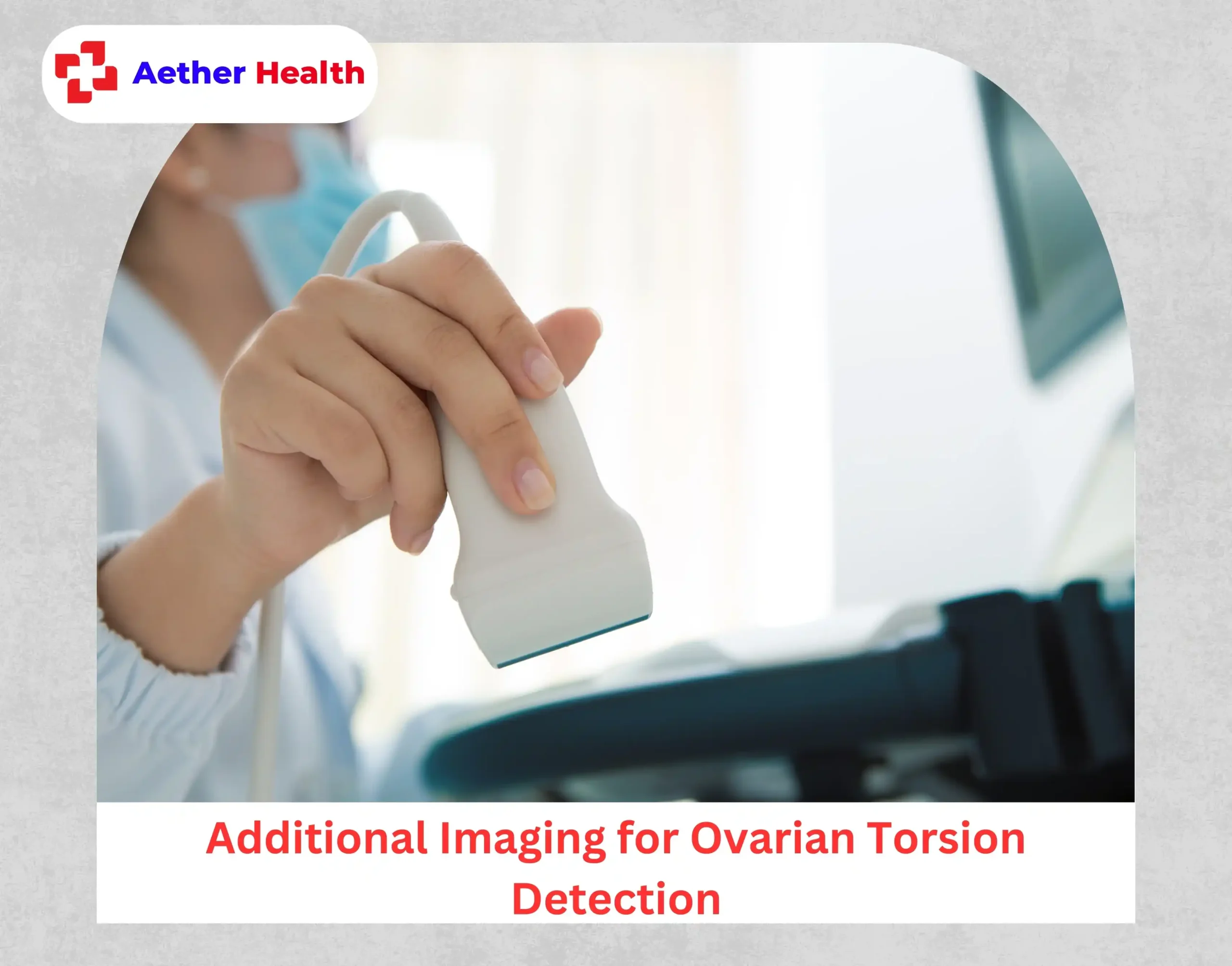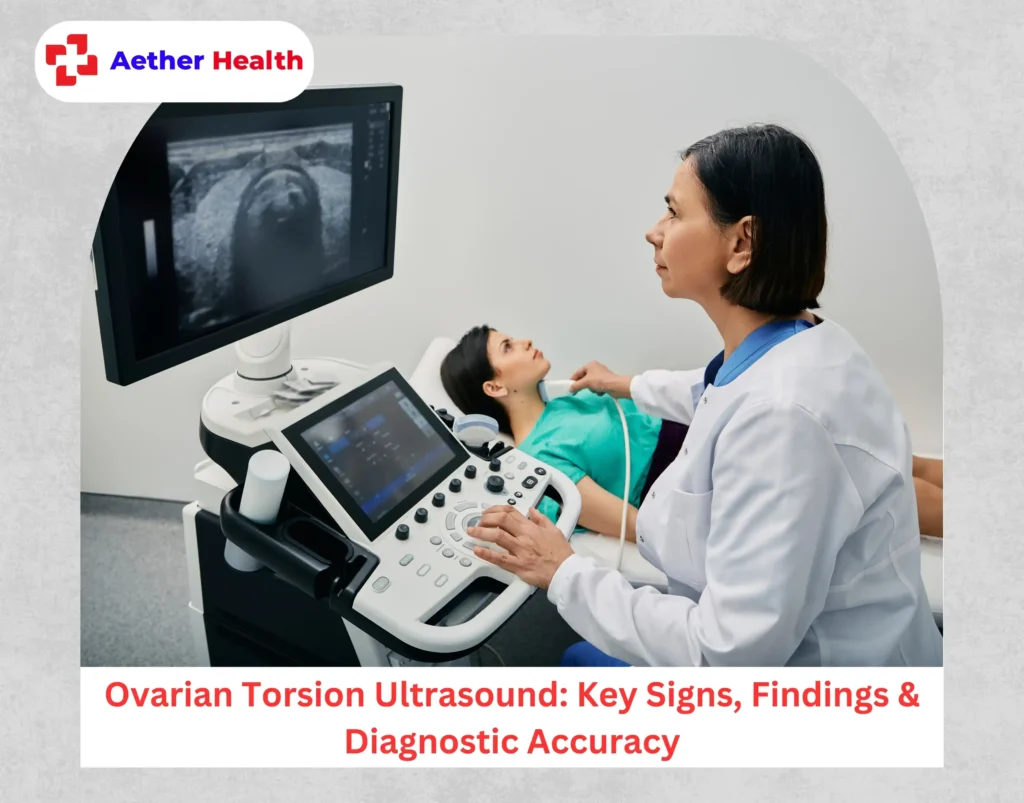When your ovary twists and cuts off its own blood supply, the damage can escalate quickly. What many women don’t realize is that ovarian torsion ultrasound results can look completely normal even in the middle of an active torsion.
Your radiologist might see a healthy-looking ovary on the screen while you’re writhing in pain from a twisted one. Blood flow can look intact. The ovary can appear normal in size. And that critical “whirlpool sign” everyone talks about may never show up at all.
So how do you know if your ultrasound truly ruled out torsion, or if you’re one of the cases that slipped through? Let’s break down what these scans actually reveal and what they miss.
What Is Ovarian Torsion and Why Ultrasound Matters

Ovarian torsion, or adnexal torsion, occurs when an ovary rotates on its supporting ligaments, cutting off the blood supply that keeps the organ alive. Most cases happen because something disrupts the ovary’s natural balance. It’s usually a cyst or tumor that adds weight to one side of the ovary, causing it to flip over and get stuck in a twisted position.
This creates a medical emergency because once the primary blood vessels twist shut, ovarian tissue begins dying within hours. This is why ovarian torsion sends women straight to the emergency room, and why getting the right diagnosis fast matters so much.
Ovarian torsion ultrasound is the go-to test because it’s available 24/7 in most emergency departments, doesn’t involve radiation, and can check blood flow in real time. Unlike CT scans or MRIs that might take hours to schedule and interpret, an ultrasound technician can wheel a machine to your bedside and start looking immediately. For a condition where time equals tissue survival, that speed advantage is huge.
Yet, ultrasound misses around one-quarter of ovarian torsion cases¹. The specificity of an ultrasound, however, is generally high. This means that if an ultrasound finds signs of torsion, the diagnosis is very likely to be correct.
Recognizing Symptoms That Lead to Ovarian Torsion Ultrasound
Sudden, Severe Pelvic Pain
The hallmark symptom is sudden, intense pelvic pain that starts at full intensity and stays severe. This isn’t cramping that builds up gradually. The pain typically affects the lower right or lower left side of abdomen in women, corresponding to whichever ovary is twisted.
Most women describe the sensation as:
- Stabbing or knife-like pain
- Sharp, constant aching
- Pain that radiates to the back, thigh, or groin
- Discomfort that doesn’t improve with position changes
Nausea and Vomiting Patterns
About 70% of women with ovarian torsion experience nausea and vomiting alongside the pain². This happens because the nerves serving your ovaries connect to the same pathways that control your digestive system.
These symptoms often start within minutes of the pain and tend to be more severe than typical stomach upset. The combination of sudden pelvic pain with immediate nausea strongly suggests the need for emergency ovarian torsion ultrasound evaluation.
Warning Signs of Partial Torsion
Some women experience intermittent episodes of similar pain days or weeks before a complete torsion occurs. This suggests partial torsion, where the ovary twists and untwists repeatedly.
These warning episodes typically:
- Last 30 minutes to several hours
- Become more frequent over time
- Increase in intensity with each occurrence
- Resolve spontaneously, leading women to delay seeking care
When Your Pelvic Pain Needs an Ultrasound
Head to the emergency room immediately if you experience:
- Sudden, severe pelvic pain that doesn’t improve within 30 minutes
- One-sided pelvic pain accompanied by nausea or vomiting
- Recurring episodes of intense pelvic pain, even if they resolve
- Severe pain during or after physical activity (exercise, sex, or sudden movements)
Don’t wait to see if symptoms improve. Ovarian tissue begins dying within hours of complete torsion, and early ovarian torsion ultrasound diagnosis significantly improves the chances of saving the ovary.
What Causes Ovarian Torsion?
Ovarian torsion is most often caused by cysts or masses that add extra weight to the ovary, tipping its balance until it twists on its ligament. The risk rises significantly when ovarian cysts grow beyond 5 cm. Most torsion cases occur in reproductive-age patients and are linked to benign masses.
Common cysts associated with ovarian torsion include:
- Functional cysts that form during ovulation
- Dermoid cysts containing tissue such as hair, skin, or teeth
- Cystadenomas, which are fluid- or mucus-filled growths
Solid benign masses can also trigger torsion by creating asymmetry. These include fibromas or mature teratomas, and other fibrous or mixed-tissue growths. The larger and heavier the ovary becomes, the greater the chance it might twist.
Can physical activity cause ovarian torsion?
Walking, exercise, or activity do not cause torsion on its own, but they can act as the final trigger in women who already have risk factors such as large cysts. In other words, a sudden movement is often the last straw, not the underlying cause.
Risk Factors Doctors Look For on Ultrasound
While cysts and masses remain the leading cause, radiologists and gynecologists consider several other factors during ovarian torsion ultrasound:
- Pregnancy-related changes: Corpus luteum cysts in the first trimester and hormone shifts that loosen ligaments make torsion more likely, especially between 6–14 weeks.
- Fertility treatments: IVF medications can enlarge both ovaries, and multiple cysts increase the risk of twisting.
- Anatomical factors: Long ovarian ligaments, past surgery, or congenital differences can give the ovaries more freedom to move.
- Age factors: Torsion is most common in reproductive years, but it can also occur in children and teens with otherwise normal ovaries. In postmenopausal women, it usually happens if there’s a mass.
What Does Ovarian Torsion Look Like on Ultrasound?

Ovarian torsion typically appears on ultrasound as an enlarged, swollen ovary with changes caused by blocked blood flow. The most reliable signs include the whirlpool pattern of twisted blood vessels, ovarian enlargement, displaced follicles, and abnormal or absent blood flow on Doppler imaging.
The Whirlpool Sign: A Strong Clue
The whirlpool sign is the most definitive ultrasound finding for ovarian torsion. Twisted blood vessels create a distinctive spiral pattern that resembles a whirlpool or snail shell.
The ovarian ligament, which carries blood vessels, twists along with the ovary, creating concentric circles visible on both standard grayscale and color Doppler ultrasound.
When present, radiologists can diagnose torsion with significant confidence³. Patient anatomy, twisting degree, and operator skill determine whether the whirlpool sign becomes visible.
Ovarian Enlargement: A Common Warning Sign
Most women with torsion have an ovary that looks swollen and round on the scan. A normal ovary measures approximately 2-5 cm in length, but with torsion, it often grows larger than 5 cm because blood and fluid get trapped inside.
Follicle displacement creates the “string of pearls” appearance. Instead of small, dark circles scattered throughout the ovary, they get pushed to the periphery by internal swelling, lining up around the organ’s border.
Blood Flow Assessment: Where Confusion Often Occurs
Normal blood flow does NOT rule out torsion. Many confirmed ovarian torsions maintain detectable arterial blood flow on ultrasound.
Each ovary receives blood from two sources: the main ovarian artery and branches from the uterine artery. When ovarian vessels twist, the backup uterine supply can maintain circulation, creating misleadingly normal Doppler patterns.
Complete absence of blood flow suggests non-viable tissue but doesn’t guarantee the ovary is unsalvageable. Normal blood flow doesn’t mean the ovary isn’t twisted. It could indicate early torsion or collateral circulation. This is why symptoms and exam findings are just as important as the scan.
Why Ultrasound Sometimes Misses Torsion
Ultrasound is the first test doctors order, but it isn’t perfect. Torsion can be missed for several reasons:
- The ovary may twist and then untwist before the scan (called intermittent torsion).
- Early torsion might not cause obvious changes yet.
- Body factors like obesity or bowel gas can block a clear view.
- The sonographer’s experience and technique matter a lot.
Because of these limits, ultrasound cannot fully rule out torsion. If the pain, exam, and risk factors are concerning, doctors may still recommend surgery even if the scan looks normal.
Additional Imaging for Ovarian Torsion Detection

While ovarian torsion ultrasound is the first-line test, it isn’t always conclusive. If symptoms remain suspicious despite normal results, doctors may order MRI for clearer soft tissue detail or CT scans when other abdominal emergencies are possible.
MRI is especially useful during pregnancy since it avoids radiation. These advanced tools can reveal twisted ligaments, ovarian swelling, or bleeding that ultrasound might miss, helping confirm the diagnosis when time is critical.
Key Takeaway
Ovarian torsion ultrasound serves as a crucial diagnostic tool, but understanding its limitations could save your ovary. While distinctive findings like the whirlpool sign provide strong evidence of torsion, roughly 25% of cases appear completely normal on imaging.
The most dangerous misconception is that normal blood flow rules out torsion. Don’t let this false security delay the care you need. Ovarian torsion remains a clinical diagnosis where physician judgment and your symptoms guide treatment decisions more than imaging alone.
FAQs
1. What is the difference between ovarian cyst and torsion?
An ovarian cyst is a fluid-filled sac on the ovary, often harmless. Torsion occurs when the ovary twists, which may be caused by a cyst or mass and leads to severe pain and loss of blood flow.
2. Can ultrasound miss ovarian torsion?
Yes. Ultrasound misses approximately 25% of ovarian torsion cases, particularly intermittent torsions where the ovary twists and untwists repeatedly.
3. How accurate is ultrasound for diagnosing ovarian torsion?
Ultrasound has over 70% sensitivity (correctly identifies most cases) and rarely gives false positives. When abnormal findings appear, torsion is very likely present.
4. What can be mistaken for ovarian torsion?
Conditions such as kidney stones, appendicitis, ectopic pregnancy, urinary tract infections, or pelvic inflammatory disease can mimic torsion symptoms.
5. How long is recovery after ovarian torsion?
Recovery usually takes a few days to a couple of weeks, depending on whether surgery was needed and if the ovary was preserved. Most patients can return to normal activities gradually.
6. How long does an ovarian torsion ultrasound take?
The exam typically takes 15-30 minutes, including both pelvic and transvaginal ultrasound with Doppler blood flow assessment.
7. Will ovarian torsion fix itself?
No. Ovarian torsion is a medical emergency requiring immediate intervention. Waiting can result in permanent ovarian loss.
8. Can ovarian torsion cause miscarriage?
Ovarian torsion does not directly cause miscarriage, but if it occurs during pregnancy, it requires urgent medical attention to protect both maternal and fetal health.



